Flex Sensor Compensator via Hammerstein–Wiener Modeling Approach for Improved Dynamic Goniometry and Constrained Control of a Bionic Hand
Abstract
1. Introduction
2. Background and Problem Statement
3. Methodology and Experimental Setup
3.1. Bionic Hand Description
3.2. Goniometric Glove with Compensators
3.3. Experimental Setup
- Gesture 1: Grab-release-grab
- Gesture 2: Number two sign
- Gesture 3: Call sign
- Gesture 4: Okay sign
- Gesture 5: Mixed Gestures A
- Gesture 6: Mixed Gestures B
4. Experimental Results and Performance Evaluations
5. Discussions and Conclusions
Author Contributions
Funding
Acknowledgments
Conflicts of Interest
Notations and Abbreviations
| i | The subscript and 5 on a symbol indicates the signal associated with the thumb, pointer, middle, ring, and pinky fingers, respectively. |
| input signal to the bionic hand’s system | |
| MCP | metacarpophalangeal |
| DIP | distal interphalangeal |
| PIP | proximal interphalangeal |
| angle measured at the DIP joint of the bionic hand | |
| angle measured at the PIP joint of the bionic hand | |
| angle measured at the MCP joint of the bionic hand (without constraint) | |
| , | lower and upper bounds of |
| the constraint imposed on | |
| angle measured at the MCP joint of the bionic hand (with constraint) | |
| angle measured at the MCP joint of the goniometric glove | |
| error or mismatch between and | |
| raw sensor value | |
| static nonlinearity after the compensator’s dynamic model | |
| static nonlinearity before the compensator’s dynamic model | |
| output of the compensator’s dynamic model | |
| input of the Hammerstein–Wiener compensator’s dynamic model | |
| unknown input disturbance within the bionic hand system | |
| P | dynamic model of the Wiener compensator |
| dynamic model of the Hammerstein–Wiener compensator | |
| microcontroller for the goniometric glove | |
| microcontroller for the bionic hand | |
| integral of absolute error | |
| final time of execution | |
| total error from each finger |
References
- Akl, A.; Feng, C.; Valaee, S. A Novel Accelerometer-Based Gesture Recognition System. IEEE Trans. Signal Process. 2011, 59, 6197–6205. [Google Scholar] [CrossRef]
- Pickering, C.A.; Burnham, K.J.; Richardson, M.J. A Research Study of Hand Gesture Recognition Technologies and Applications for Human Vehicle Interaction. In Proceedings of the 2007 3rd Institution of Engineering and Technology Conference on Automotive Electronics, Warwick, UK, 28–29 June 2007; pp. 1–15. [Google Scholar]
- Kaur, H.; Rani, J. A review: Study of various techniques of Hand gesture recognition. In Proceedings of the 2016 IEEE 1st International Conference on Power Electronics, Intelligent Control and Energy Systems (ICPEICES), Delhi, India, 4–6 July 2016; pp. 1–5. [Google Scholar]
- Sonkusare, J.S.; Chopade, N.B.; Sor, R.; Tade, S.L. A Review on Hand Gesture Recognition System. In Proceedings of the 2015 International Conference on Computing Communication Control and Automation, Pune, India, 26–27 February 2015; pp. 790–794. [Google Scholar]
- Rautaray, S.S.; Agrawal, A. Vision based hand gesture recognition for human computer interaction: A survey. Artif. Intell. Rev. 2015, 43, 1–54. [Google Scholar] [CrossRef]
- Ahmed, M.A.; Zaidan, B.B.; Zaidan, A.A. A Review on Systems-Based Sensory Gloves for Sign Language Recognition State of the Art between 2007 and 2017. Sensors 2018, 18, 2208. [Google Scholar] [CrossRef] [PubMed]
- Vivar, G.; Almanza-Ojeda, D.L.; Cheng, I.; Gomez, J.C.; Andrade-Lucio, J.A.; Ibarra-Manzano, M.A. Contrast and Homogeneity Feature Analysis for Classifying Tremor Levels in Parkinson’s Disease Patients. Sensors 2019, 19, 2072. [Google Scholar] [CrossRef] [PubMed]
- Simone, L.K.; Sundarrajan, N.; Luo, X.; Jia, Y.; Kamper, D.G. A low cost instrumented glove for extended monitoring and functional hand assessment. J. Neurosci. Methods 2007, 160, 335–348. [Google Scholar] [CrossRef] [PubMed]
- Alonso-Martín, F.; Gamboa-Montero, J.J.; Castillo, J.C.; Castro-González, l.; Salichs, M.N. Detecting and Classifying Human Touches in a Social Robot Through Acoustic Sensing and Machine Learning. Sensors 2017, 17, 1138. [Google Scholar] [CrossRef] [PubMed]
- Liu, H.; Wang, L. Gesture recognition for human-robot collaboration: A review. Int. J. Ind. Ergon. 2018, 68, 355–367. [Google Scholar] [CrossRef]
- Lv, Z.; Halawani, A.; Feng, S.; ur Réhman, S.; Li, H. Touch-less interactive augmented reality game on vision-based wearable device. Pers. Ubiquitous Comput. 2015, 19, 551–567. [Google Scholar] [CrossRef]
- Murthy, G.; Jadon, R. A review of vision based hand gesture recognition. Int. J. Inf. Technol. Knowl. Manag. 2009, 2, 405–410. [Google Scholar]
- Dipietro, L.; Sabatini, A.M.; Dario, P. A Survey of Glove-Based Systems and Their Applications. IEEE Trans. Syst. Man. Cybern. C 2008, 38, 461–482. [Google Scholar] [CrossRef]
- Reifinger, S.; Wallhoff, F.; Ablassmeier, M.; Poitschke, T.; Rigoll, G. Static and Dynamic Hand-Gesture Recognition for Augmented Reality Applications. In Proceedings of the International Conference on Human-Computer Interaction, Beijing, China, 22–27 July 2007; pp. 728–737. [Google Scholar]
- Zengeler, N.; Kopinski, T.; Handmann, U. Hand Gesture Recognition in Automotive Human–Machine Interaction Using Depth Cameras. Sensors 2018, 19, 59. [Google Scholar] [CrossRef] [PubMed]
- Mueller, F.; Mehta, D.; Sotnychenko, O.; Sridhar, S.; Casas, D.; Theobalt, C. Real-time Hand Tracking under Occlusion from an Egocentric RGB-D Sensor. CoRR 2017, abs/1704.02201, 1284–1293. [Google Scholar]
- Du, G.; Zhang, P. A Markerless Human–Robot Interface Using Particle Filter and Kalman Filter for Dual Robots. IEEE Trans. Ind. Electron. 2015, 62, 2257–2264. [Google Scholar] [CrossRef]
- Chong, T.W.; Lee, B.G. American Sign Language Recognition Using Leap Motion Controller with Machine Learning Approach. Sensors 2018, 18, 3554. [Google Scholar] [CrossRef] [PubMed]
- Nizamis, K.; Rijken, N.H.M.; Mendes, A.; Janssen, M.M.H.P.; Bergsma, A.; Koopman, B.F.J.M. A Novel Setup and Protocol to Measure the Range of Motion of the Wrist and the Hand. Sensors 2018, 18, 3230. [Google Scholar] [CrossRef] [PubMed]
- Bachmann, D.; Weichert, F.; Rinkenauer, G. Review of Three-Dimensional Human-Computer Interaction with Focus on the Leap Motion Controller. Sensors 2018, 18, 2194. [Google Scholar] [CrossRef] [PubMed]
- Wang, S.; Parsons, M.; Stone-McLean, J.; Rogers, P.; Boyd, S.; Hoover, K.; Meruvia-Pastor, O.; Gong, M.; Smith, A. Augmented Reality as a Telemedicine Platform for Remote Procedural Training. Sensors 2017, 17, 2294. [Google Scholar] [CrossRef] [PubMed]
- Kim, M.; Jeon, C.; Kim, J. A Study on Immersion and Presence of a Portable Hand Haptic System for Immersive Virtual Reality. Sensors 2017, 17, 1141. [Google Scholar]
- Guzsvinecz, T.; Szucs, V.; Sik-Lanyi, C. Suitability of the Kinect Sensor and Leap Motion Controller—A Literature Review. Sensors 2019, 19, 1702. [Google Scholar] [CrossRef] [PubMed]
- Kumar, P.; Gauba, H.; Roy, P.P.; Dogra, D.P. A multimodal framework for sensor based sign language recognition. Neurocomputing 2017, 259, 21–38. [Google Scholar] [CrossRef]
- Chen, Z.H.; Kim, J.T.; Liang, J.; Zhang, J.; Yuan, Y.B. Real-Time Hand Gesture Recognition Using Finger Segmentation. Sci. World J. 2017, 2014, 9. [Google Scholar] [CrossRef] [PubMed]
- Ponraj, G.; Ren, H. Sensor Fusion of Leap Motion Controller and Flex Sensors Using Kalman Filter for Human Finger Tracking. IEEE Sens. J. 2018, 18, 2042–2049. [Google Scholar] [CrossRef]
- Orengo, G.; Lagati, A.; Saggio, G. Modeling Wearable Bend Sensor Behavior for Human Motion Capture. IEEE Sens. J. 2014, 14, 2307–2316. [Google Scholar] [CrossRef]
- Norkin, C.C.; White, D.J. Measurement Of Joint Motion: A Guide To Goniometry; F.A. Davis Company: Philadelphia, PA, USA, 2017. [Google Scholar]
- Lai, H.Y.; Ke, H.Y.; Hsu, Y.C. Real-time Hand Gesture Recognition System and Application. Sens. Mater. 2018, 30, 869–884. [Google Scholar]
- Addin, I.; Sidig, A.; Luqman, H.; Mahmoud, S.A. Transform-based Arabic sign language recognition. Proc. Comput. Sci. 2017, 117, 2–9. [Google Scholar]
- Hellebrandt, F.A.; Duvall, E.N.; Moore, M.L. The Measurement of Joint Motion: Part III—Reliability of Goniometry*. Phys. Ther. 1949, 29, 302–307. [Google Scholar] [CrossRef]
- Wise, S.L.; Gardner, W.T.; Sabelman, E.E.; Valainis, E.; Wong, Y.C.; Glass, K.; Drace, J.E.; Rosen, J.M. Evaluation of a fiber optic glove for semi-automated goniometric measurements. J. Rehabilit. Res. Dev. 1990, 27, 411–424. [Google Scholar] [CrossRef]
- Kessler, G.D.; Hodges, L.F.; Walker, N. Evaluation of the CyberGlove As a Whole-hand Input Device. ACM Trans. Comput.-Hum. Interact. 1995, 2, 263–283. [Google Scholar] [CrossRef]
- Dipietro, L.; Sabatini, A.M.; Dario, P. Evaluation of an instrumented glove for hand-movement acquisition. J. Rehabilit. Res. Dev. 2003, 40 2, 179–189. [Google Scholar] [CrossRef]
- Tani, B.S.; Maia, R.S.; von Wangenheim, A. A Gesture Interface for Radiological Workstations. In Proceedings of the Twentieth IEEE International Symposium on Computer-Based Medical Systems, Maribor, Slovenia, 20–22 June 2007; pp. 27–32. [Google Scholar]
- Vamplew, P. Recognition of Sign Language Gestures Using Neural Networks. In Proceedings of the 1st European Conference on Disability, Virtual Reality and Associated Technologies, Maidenhead, UK, 8–10 July 1996; pp. 39–48. [Google Scholar]
- Min, B.-W.; Yoon, H.-S.; Soh, J.; Yang, Y.-M.; Ejima, T. Hand gesture recognition using hidden Markov models. In Proceedings of the 1997 IEEE International Conference on Systems, Man, and Cybernetics. Computational Cybernetics and Simulation, Orlando, FL, USA, 12–15 October 1997; pp. 4232–4235. [Google Scholar]
- Kao, C.Y.; Fahn, C.S. A Human-Machine Interaction Technique: Hand Gesture Recognition Based on Hidden Markov Models with Trajectory of Hand Motion. Proc. Eng. 2011, 15, 3739–3743. [Google Scholar] [CrossRef]
- Tu, J.V. Advantages and disadvantages of using artificial neural networks versus logistic regression for predicting medical outcomes. J. Clin. Epidemiol. 1996, 49, 122–1231. [Google Scholar] [CrossRef]
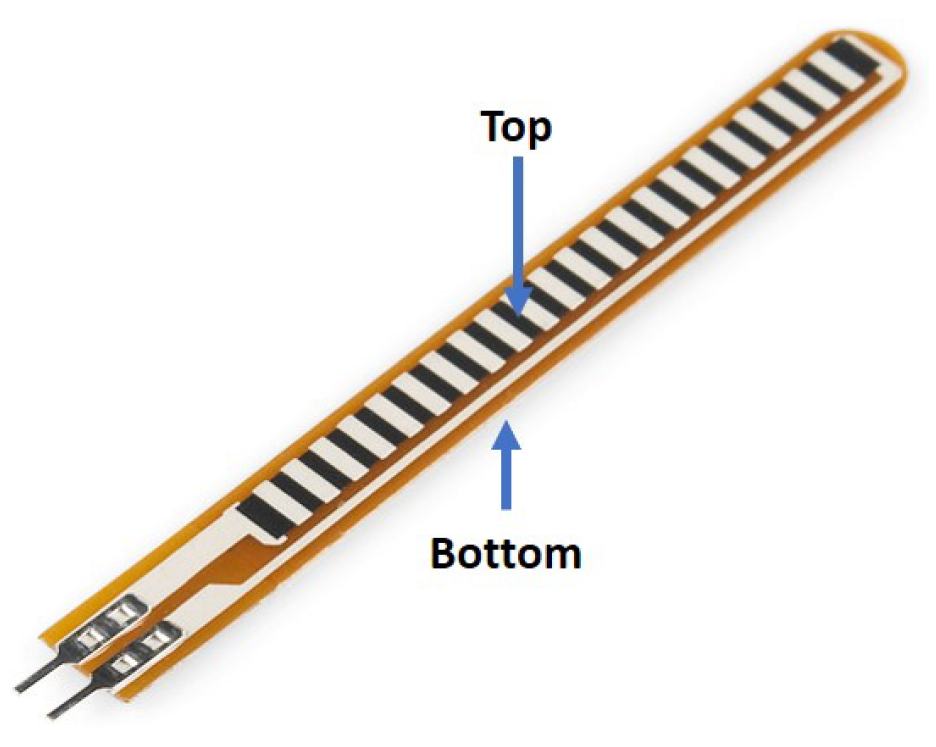

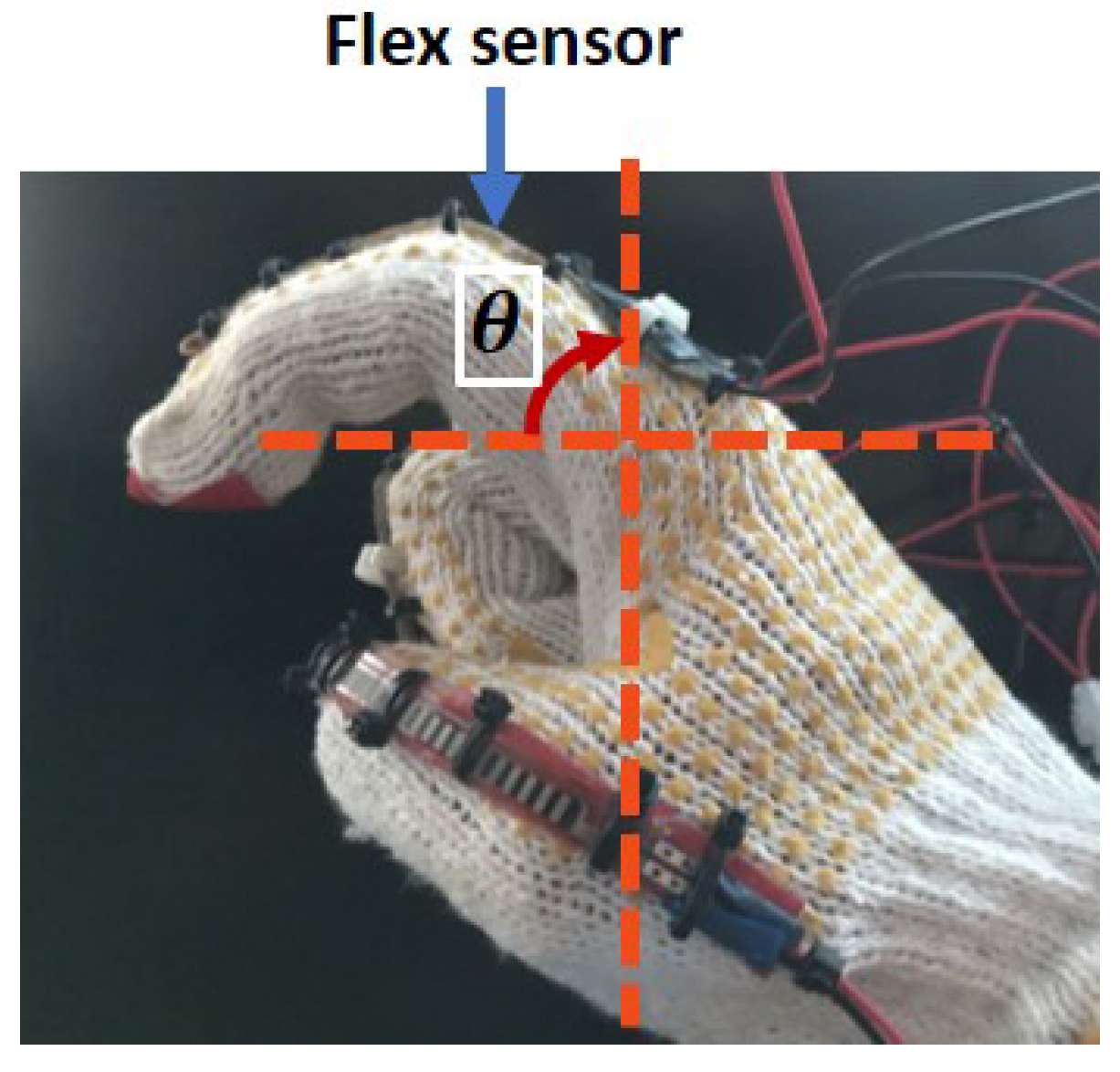


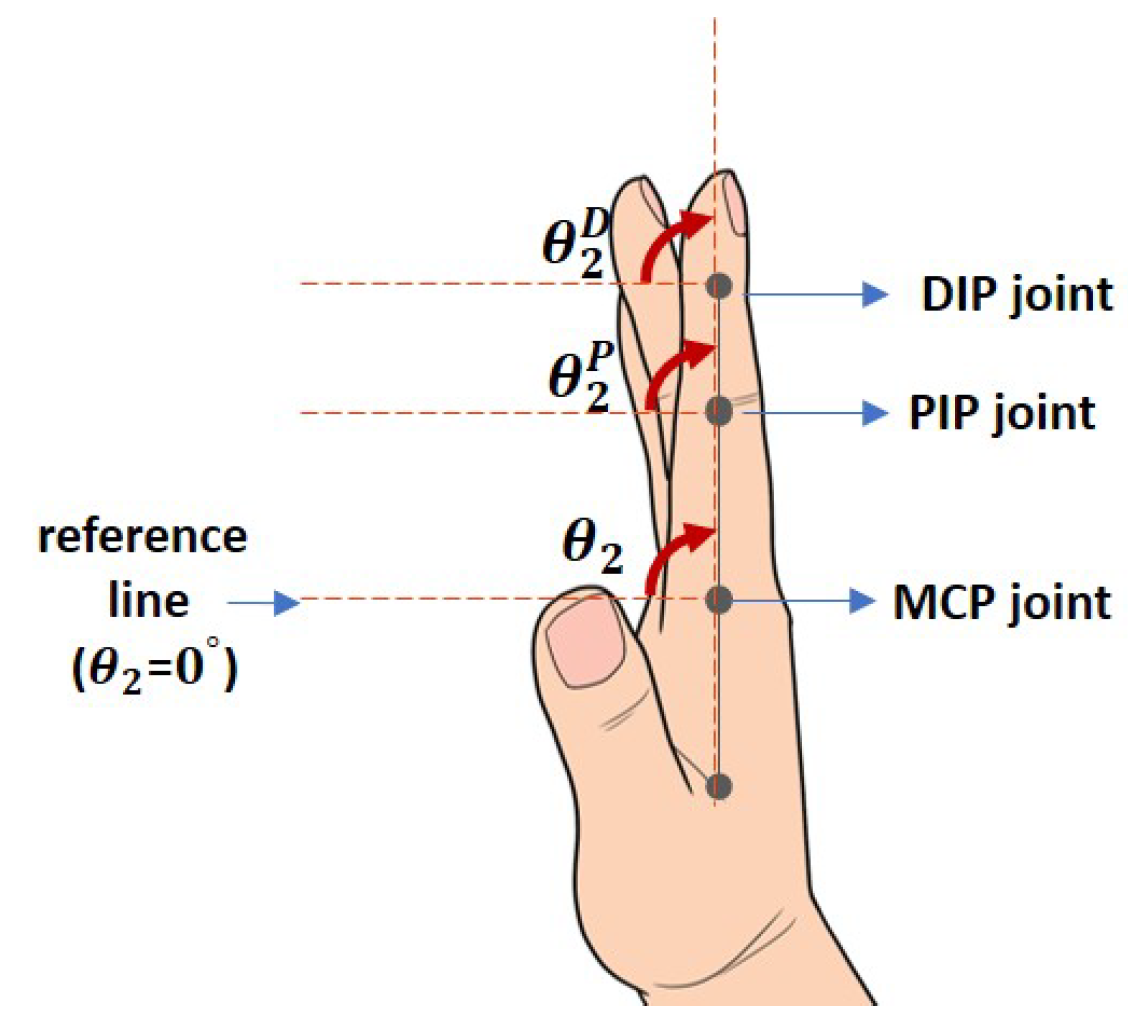
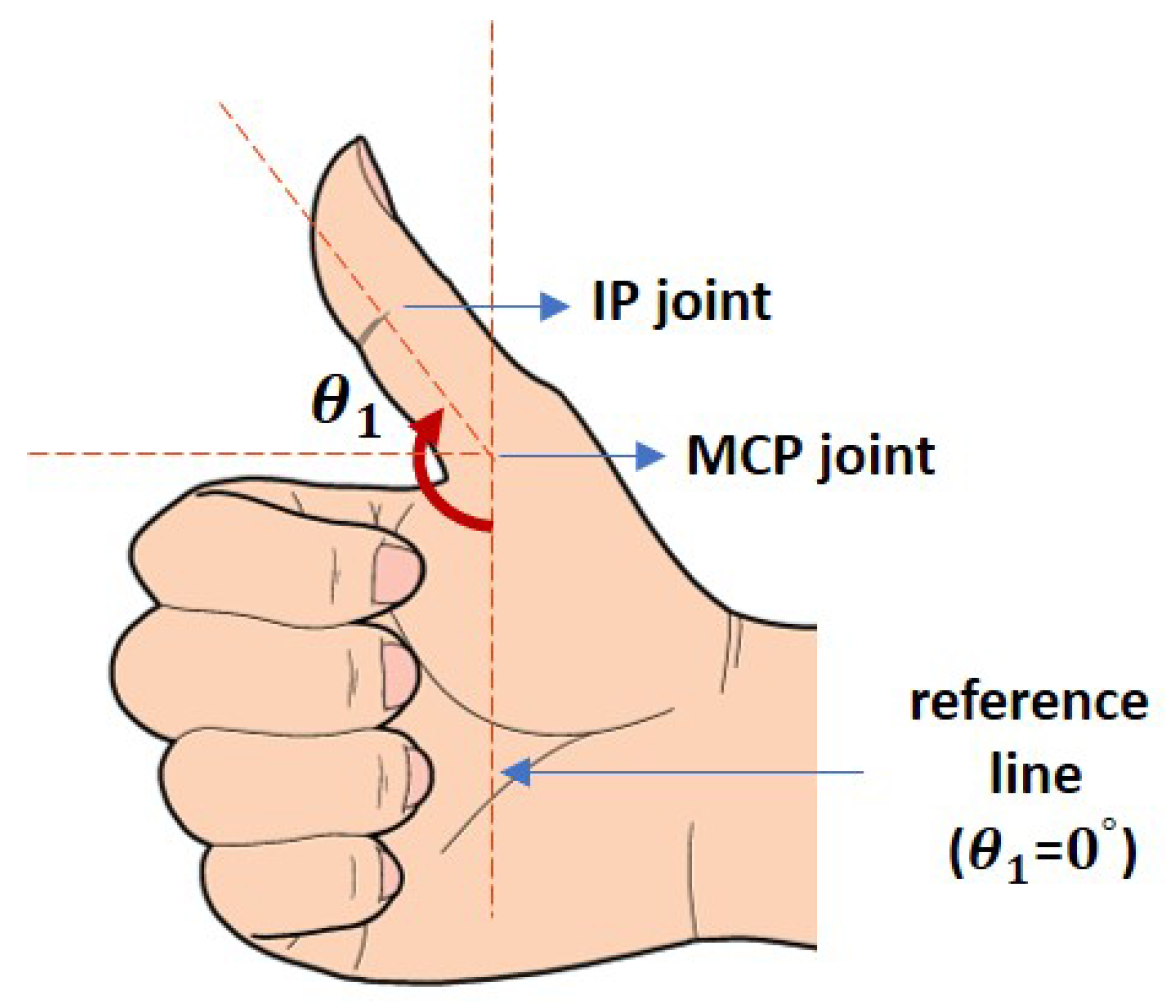
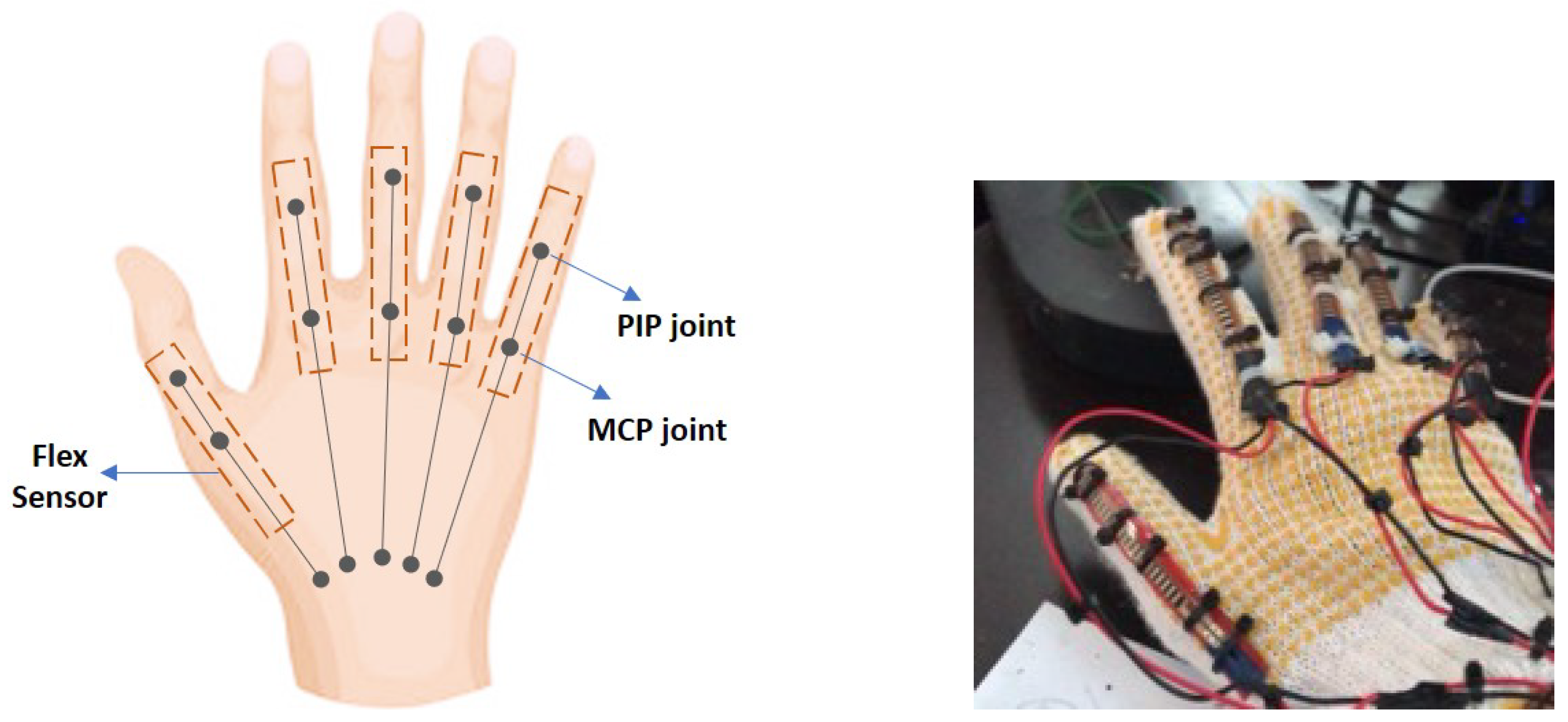
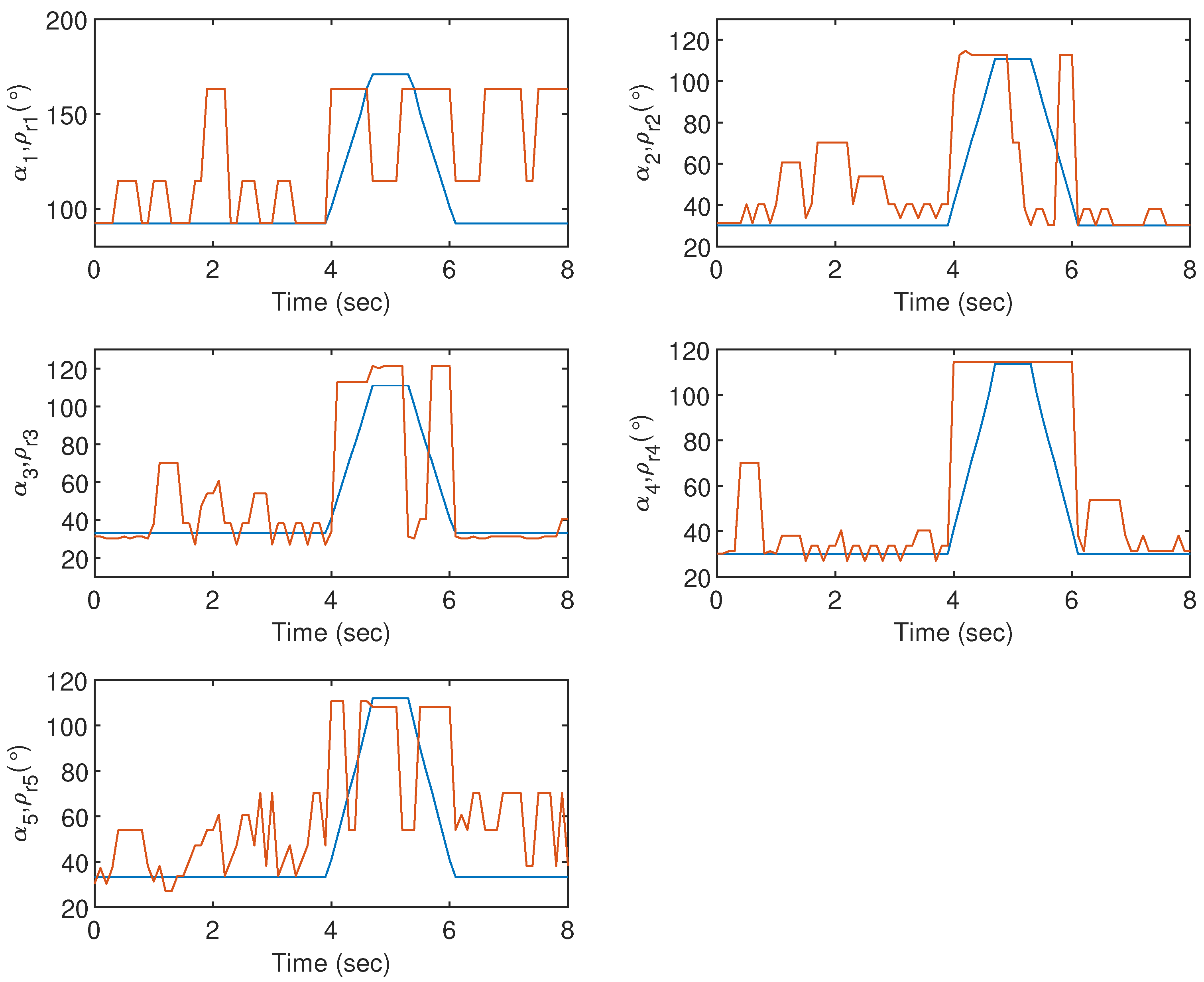




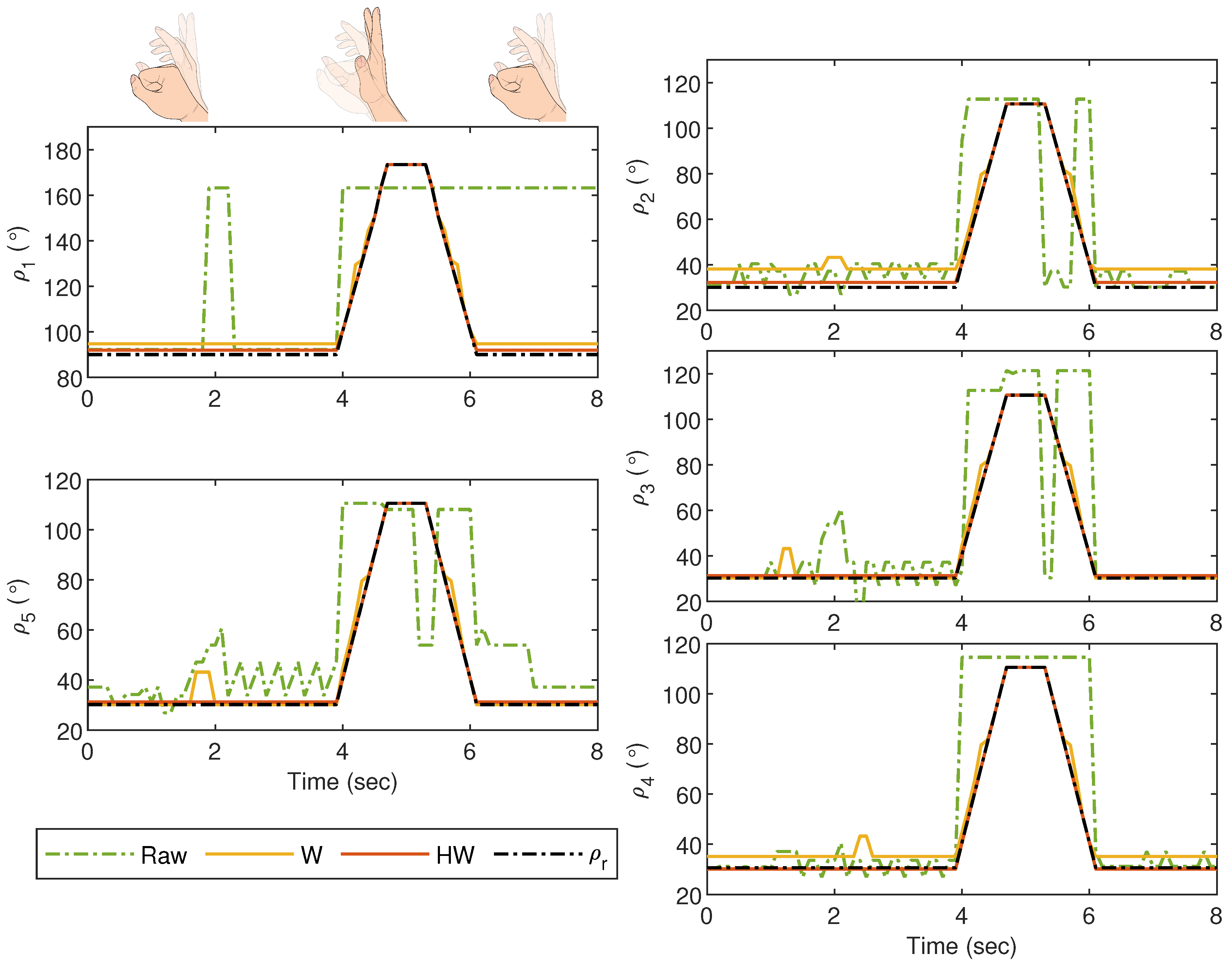

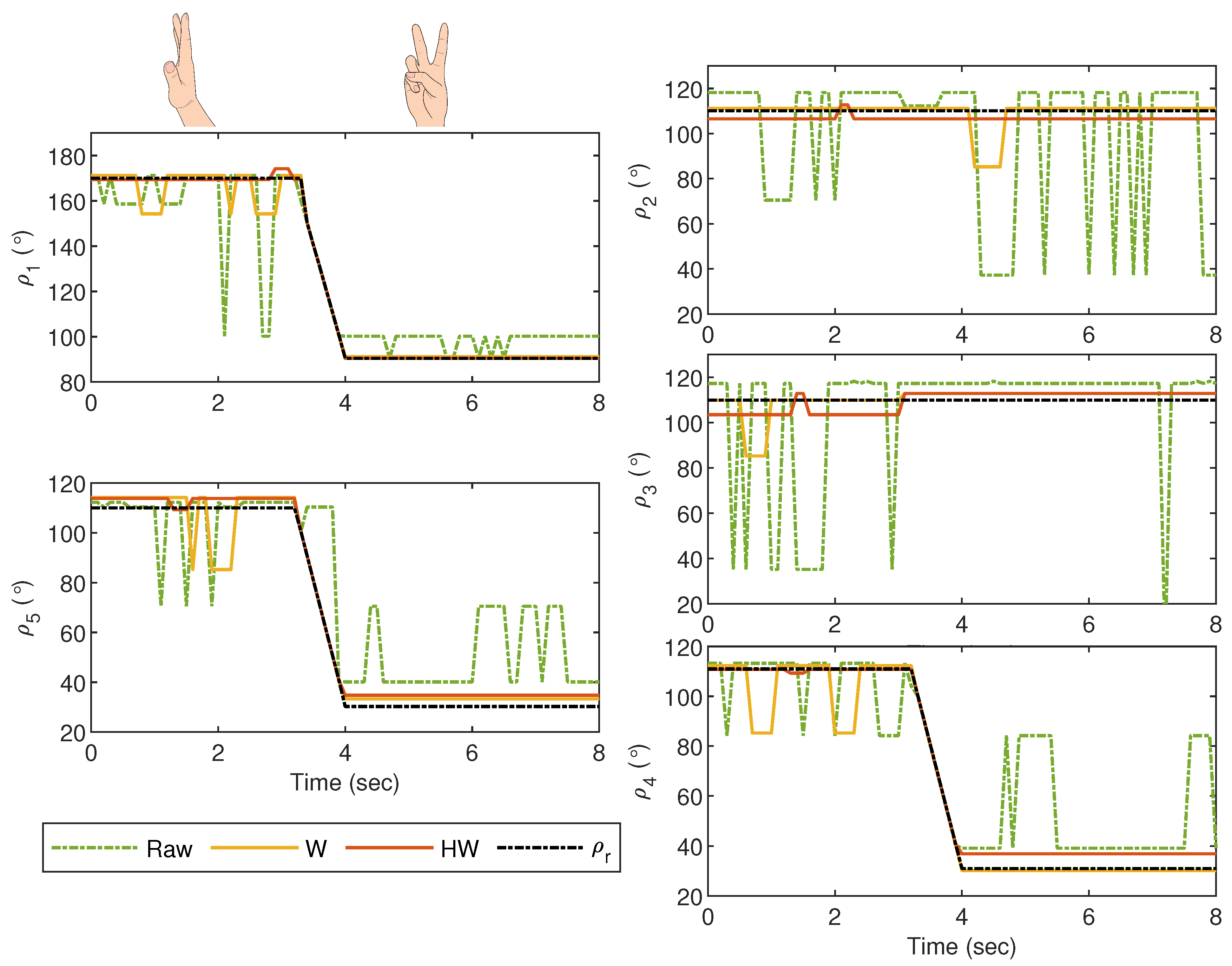


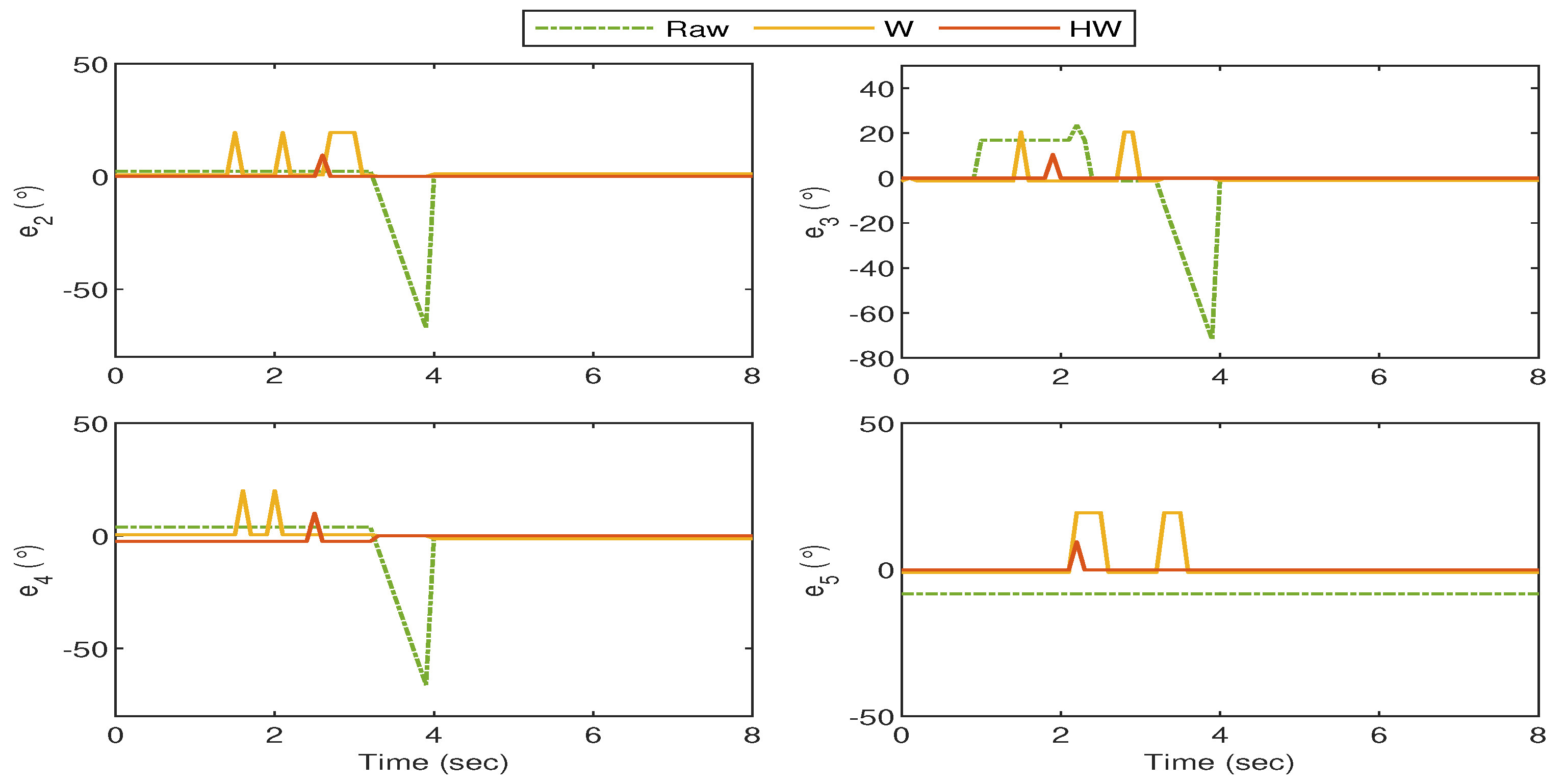
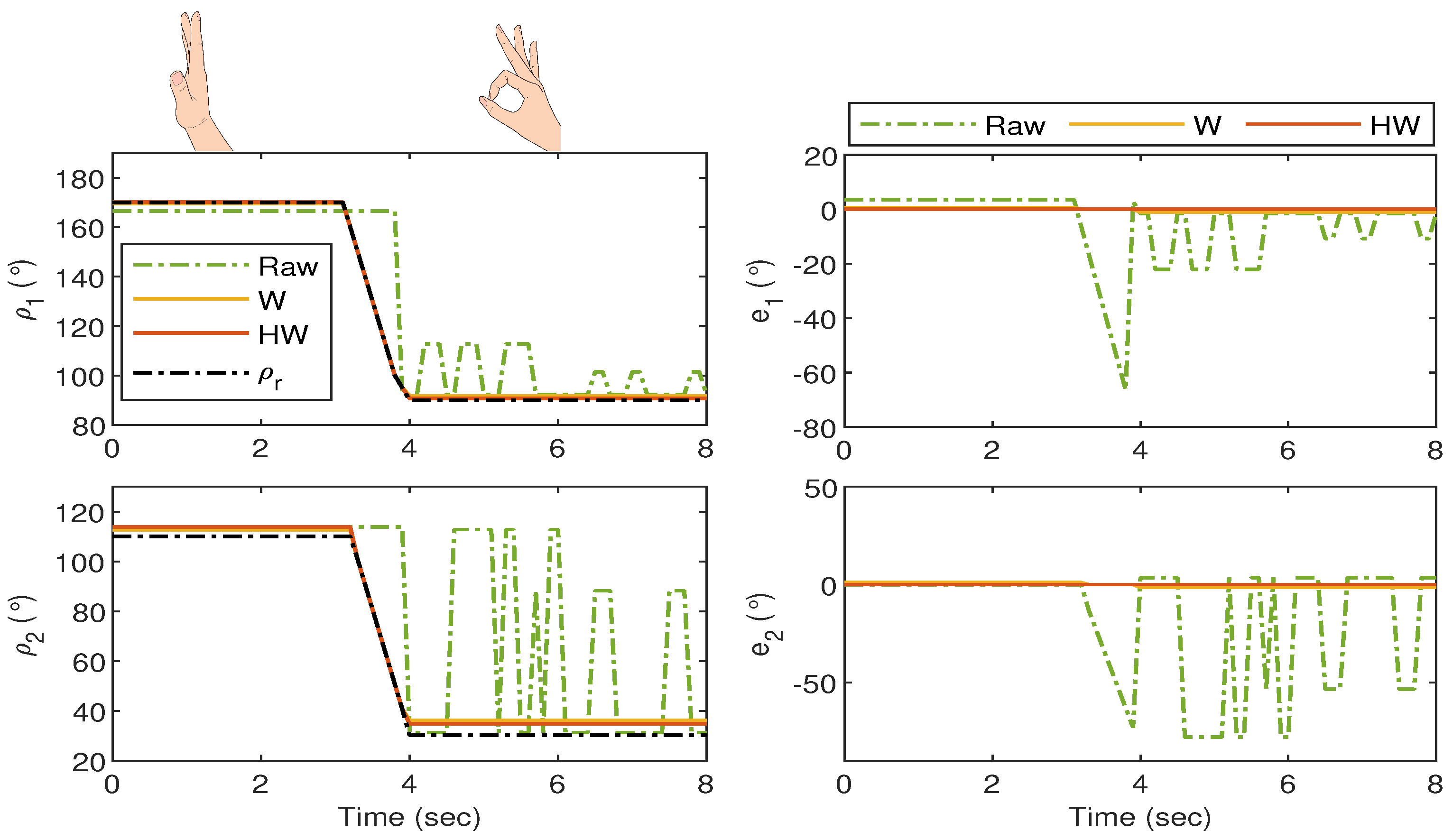
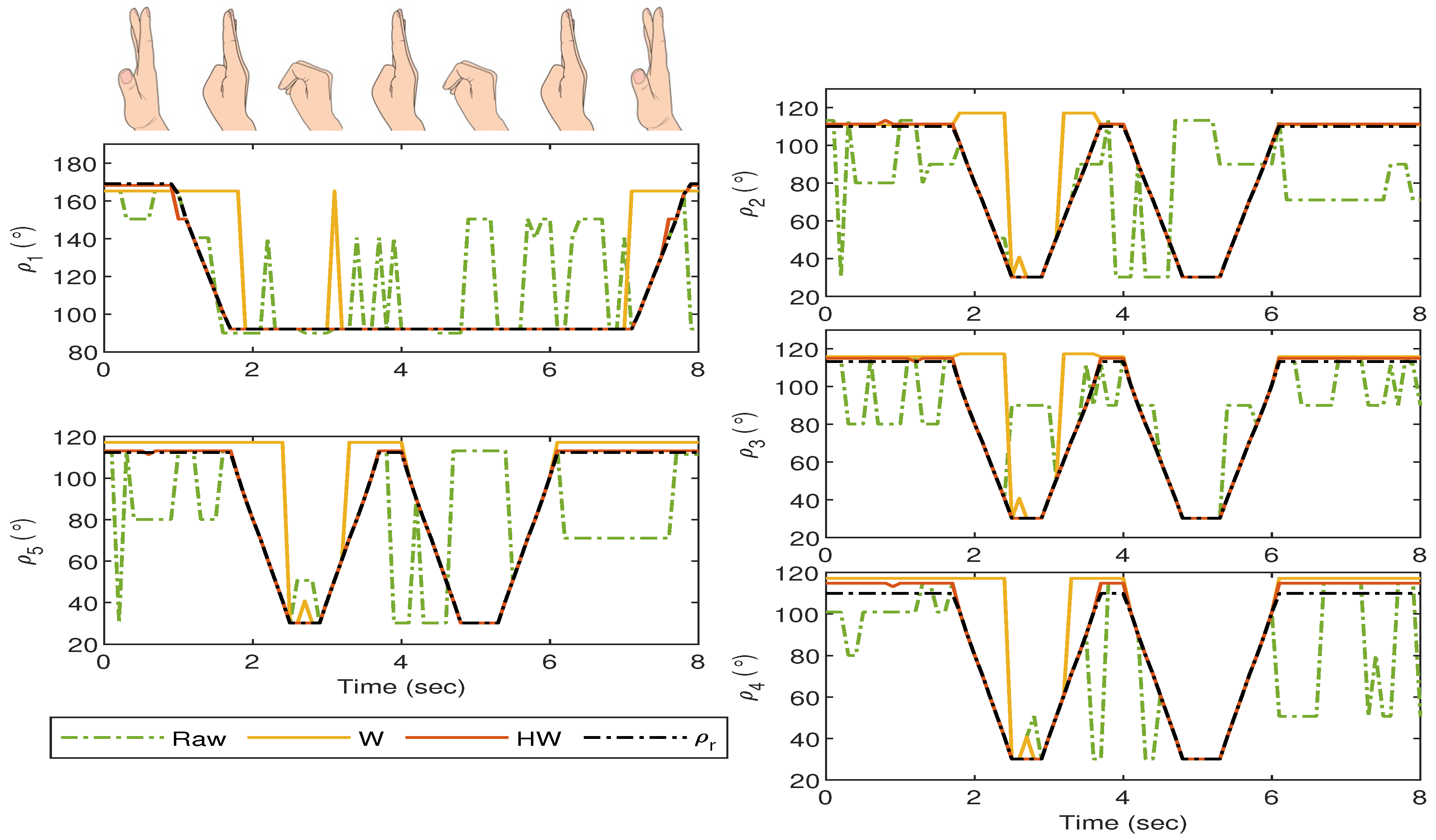
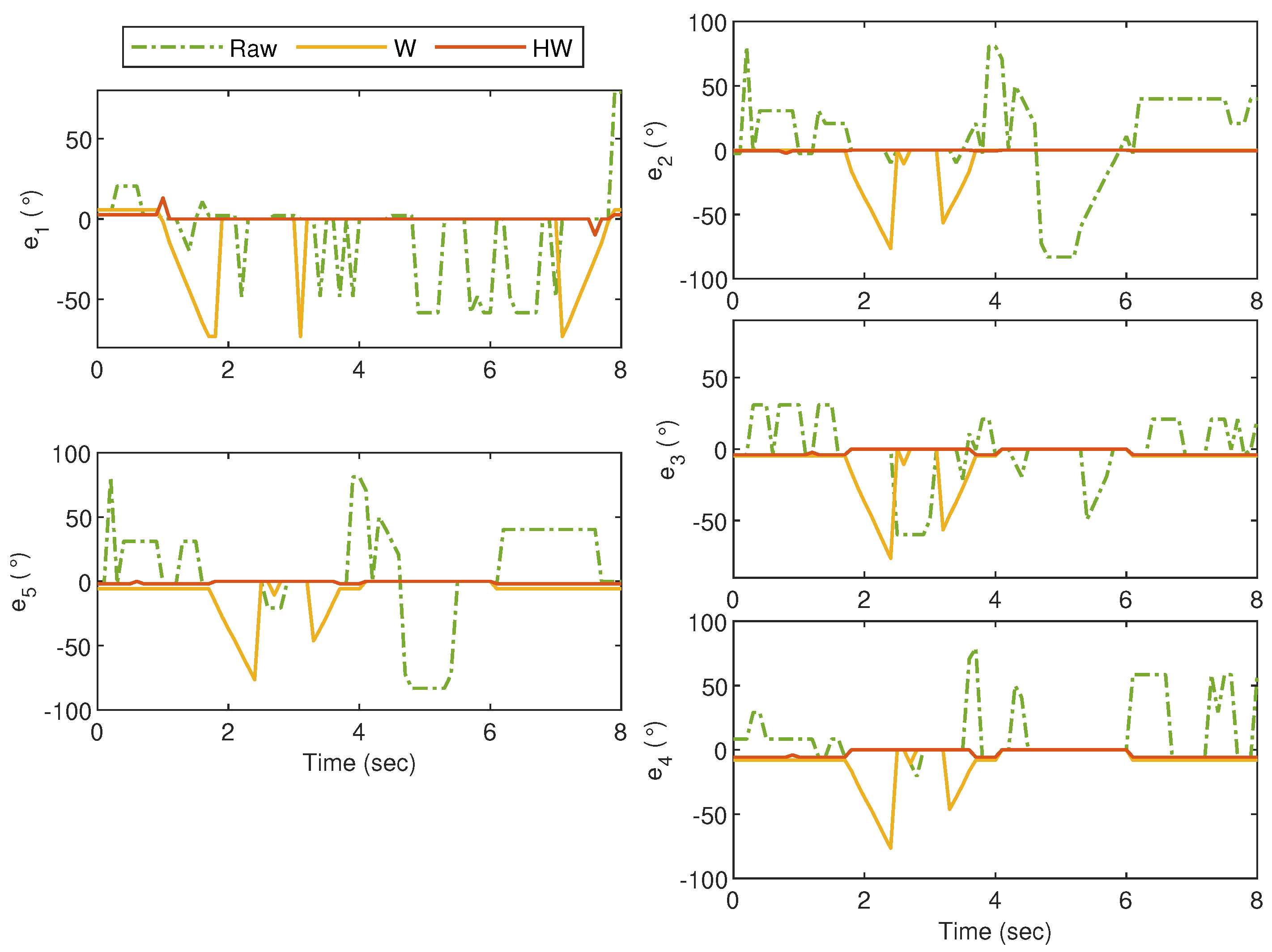
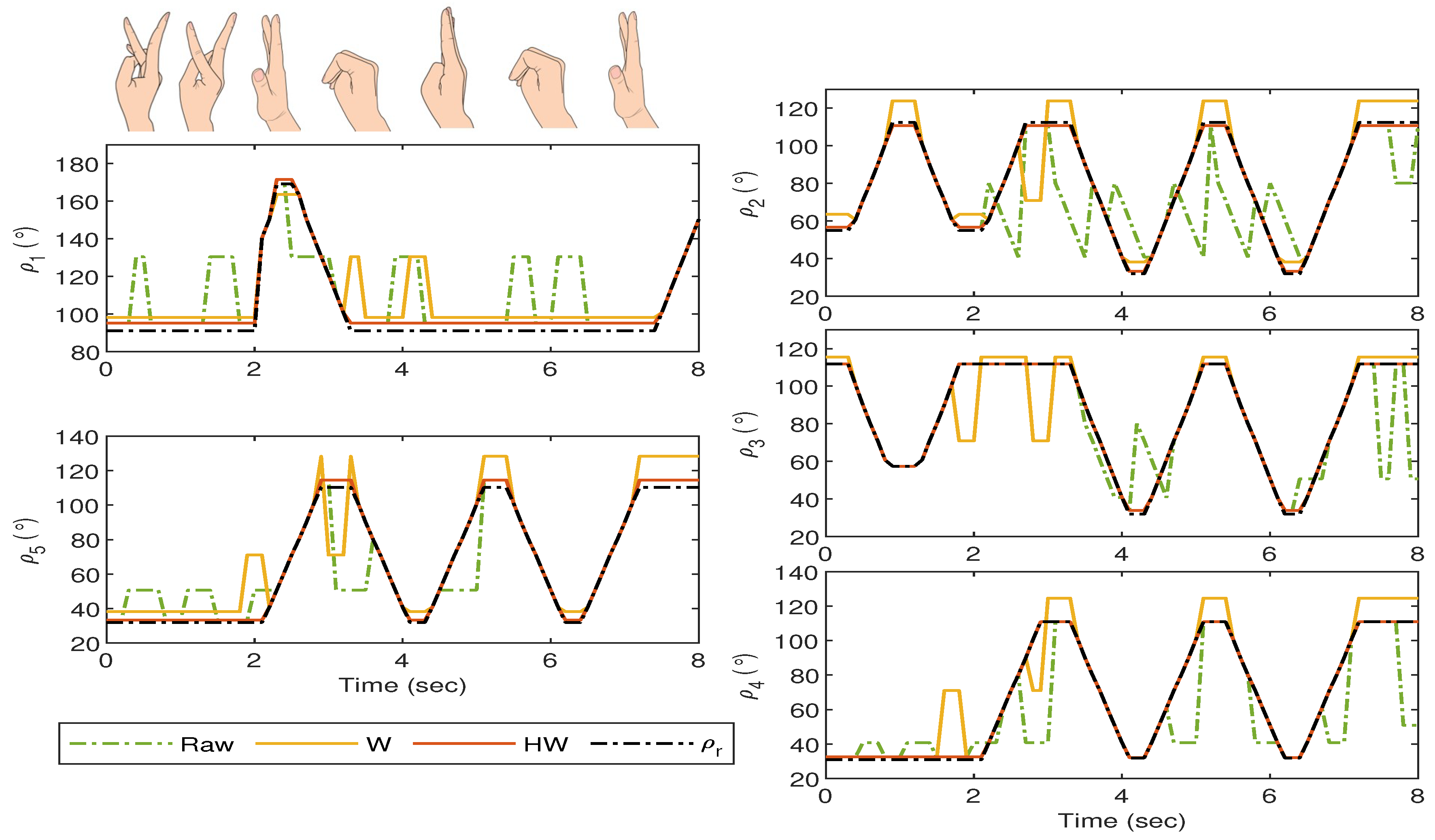

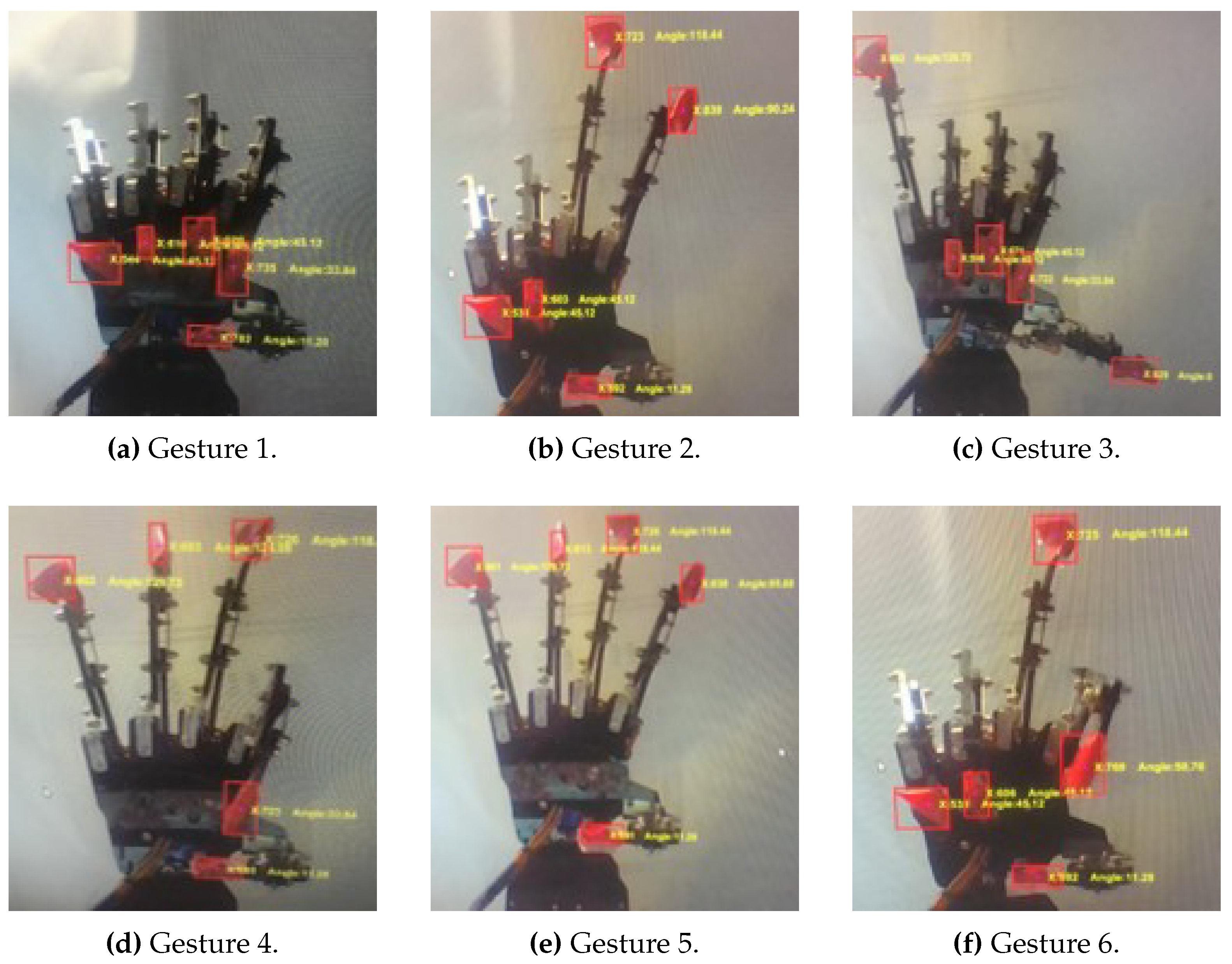
| Gesture | 1 | 2 | 3 | 4 | 5 | 6 |
|---|---|---|---|---|---|---|
| Trial 1 | 1036.2 | 1701.5 | 2014.2 | 1201.2 | 1479 | 418.5 |
| Trial 2 | 545.71 | 654.14 | 1023.1 | 721.78 | 1080.25 | 525.3 |
| Trial 3 | 461.21 | 512.23 | 1001.2 | 657.12 | 700.23 | 602.3 |
| Average | 681.04 | 956.0 | 1346.2 | 860.0 | 1086.5 | 515.4 |
| Wiener | Hammerstein–Wiener | |||||||||||
|---|---|---|---|---|---|---|---|---|---|---|---|---|
| Gesture | 1 | 2 | 3 | 4 | 5 | 6 | 1 | 2 | 3 | 4 | 5 | 6 |
| Trial 1 | 354.2 | 412.21 | 401.28 | 70.254 | 299.5 | 315.9 | 136.7 | 97.75 | 254.3 | 76.76 | 39.47 | 48.4 |
| Trial 2 | 144.25 | 152.25 | 101.25 | 98.321 | 441.2 | 401 | 49.8 | 39.1 | 39.34 | 37.03 | 108.3 | 81.3 |
| Trial 3 | 60.214 | 101.27 | 124.27 | 452.12 | 300.2 | 389.3 | 6.131 | 6.137 | 12.08 | 3.283 | 85.3 | 104.9 |
| Average | 186.25 | 221.91 | 208.93 | 206.90 | 347 | 368.7 | 64.21 | 47.66 | 101.90 | 39.02 | 77.69 | 78.2 |
© 2019 by the authors. Licensee MDPI, Basel, Switzerland. This article is an open access article distributed under the terms and conditions of the Creative Commons Attribution (CC BY) license (http://creativecommons.org/licenses/by/4.0/).
Share and Cite
Syed Mubarak Ali, S.A.A.; Ahmad, N.S.; Goh, P. Flex Sensor Compensator via Hammerstein–Wiener Modeling Approach for Improved Dynamic Goniometry and Constrained Control of a Bionic Hand. Sensors 2019, 19, 3896. https://doi.org/10.3390/s19183896
Syed Mubarak Ali SAA, Ahmad NS, Goh P. Flex Sensor Compensator via Hammerstein–Wiener Modeling Approach for Improved Dynamic Goniometry and Constrained Control of a Bionic Hand. Sensors. 2019; 19(18):3896. https://doi.org/10.3390/s19183896
Chicago/Turabian StyleSyed Mubarak Ali, Syed Afdar Ali, Nur Syazreen Ahmad, and Patrick Goh. 2019. "Flex Sensor Compensator via Hammerstein–Wiener Modeling Approach for Improved Dynamic Goniometry and Constrained Control of a Bionic Hand" Sensors 19, no. 18: 3896. https://doi.org/10.3390/s19183896
APA StyleSyed Mubarak Ali, S. A. A., Ahmad, N. S., & Goh, P. (2019). Flex Sensor Compensator via Hammerstein–Wiener Modeling Approach for Improved Dynamic Goniometry and Constrained Control of a Bionic Hand. Sensors, 19(18), 3896. https://doi.org/10.3390/s19183896






